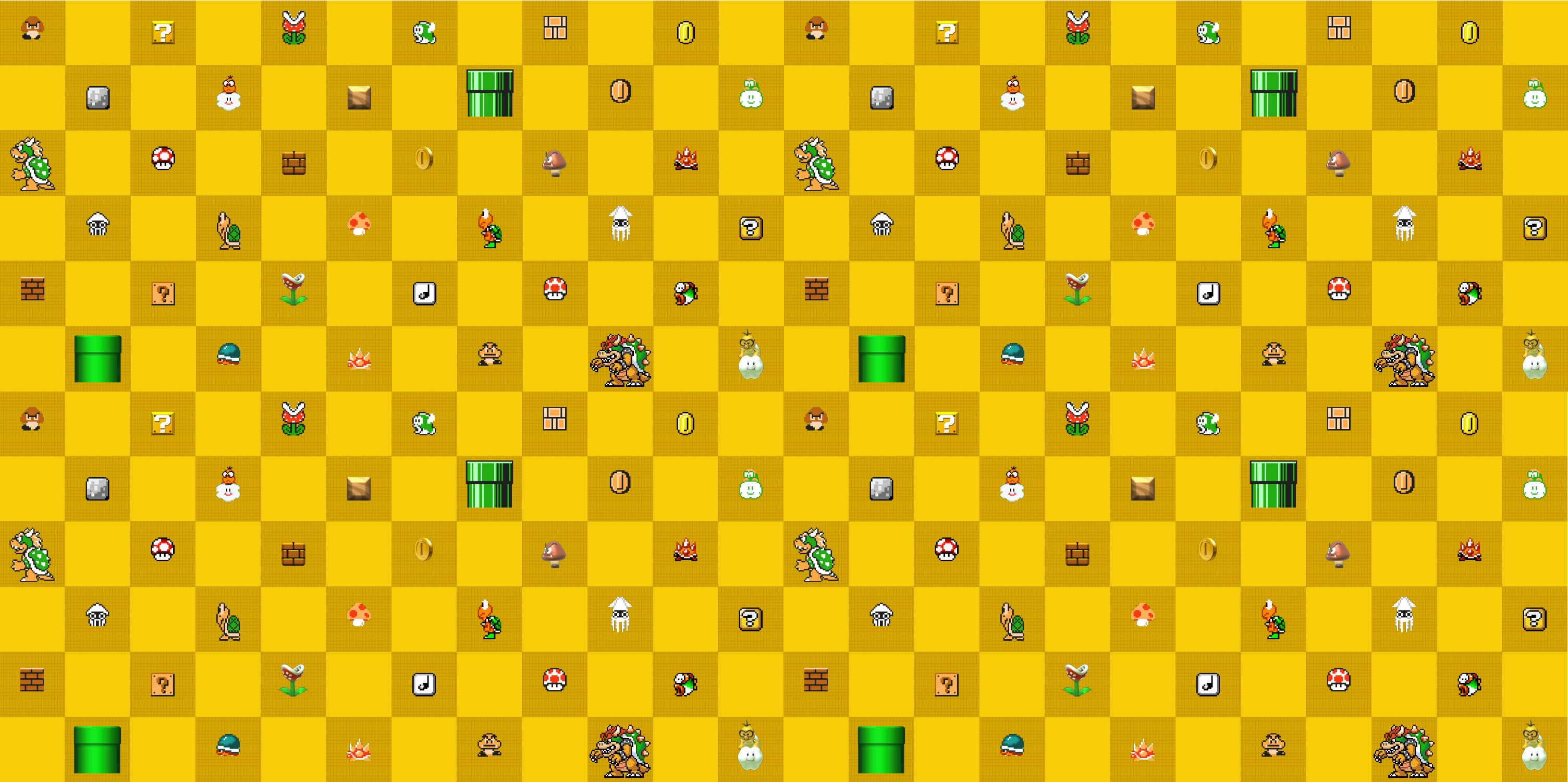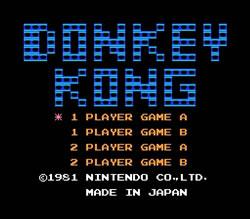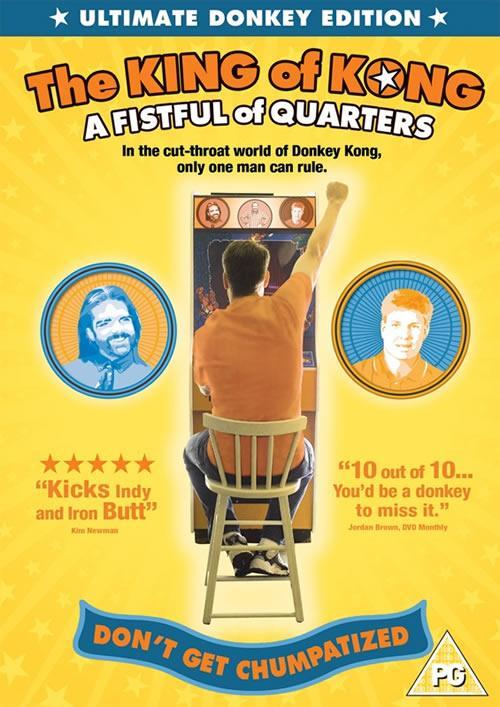|
|
NES Version Release dates
General information Developed by Nintendo R&D1 Published by Nintendo Players: 1-2 |
||||||||||||
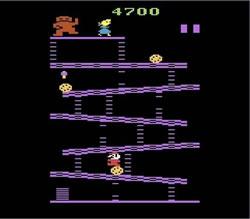 |
Atari 2600 Version Release dates
General information Developed by AtariSoft Published by Nintendo Players: 1-2 |
||||||||||||
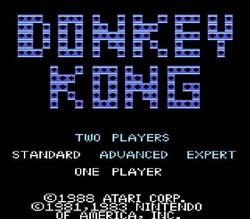 |
Atari 7800 Version Release dates
General information Developed by AtariSoft Published by Nintendo Players: 1-2 |
||||||||||||
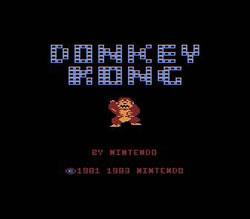 |
Atari 800 Version Release dates
General information Developed by AtariSoft Published by Nintendo Players: 1-2 |
||||||||||||
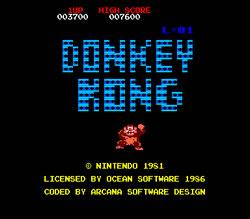 |
Amstrad CPC Version Release dates
General information Developed by Ocean Software Published by Nintendo Players: 1-2 |
||||||||||||
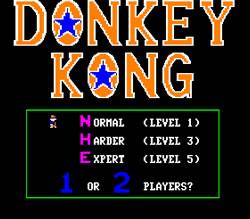 |
Apple II Version Release dates
General information Developed by AtariSoft Published by AtariSoft Players: 1-2 |
||||||||||||
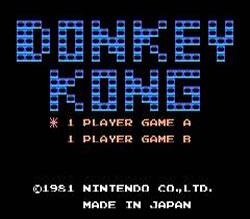 |
e-Reader version Release dates
General information Developed by Nintendo Published by Nintendo Players: 1-2 |
||||||||||||
 |
Intellivision Version Release dates
General information Developed by Coleco Published by Nintendo Players: 1-2 |
on
![]() Buy Donkey Kong (NES)
Buy Donkey Kong (NES)
on
![]()
Quick links: Overview / Story / Mario's Origin / Gameplay and Controls / Characters and Enemies / Items, Objects and Power-ups / Stages / Releases / The King of Kong: A Fist Full of Quarters / References in later games / Legal issues / Videos - Gameplay, Trailers & Commercials / Reception and Sales / World Records / Trivia and Facts / Reference & Information / Media & Downloads
Overview
Donkey Kong is a platform video game
developed by Nintendo. It was originally released in 1981 (on the arcades).
Following the success and popularity of the arcade original, there were many
other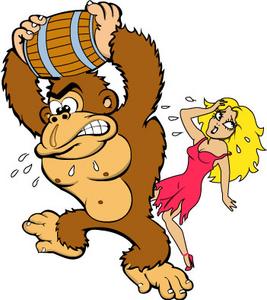 versions of this title as well (it was later released on: Intellivision,
Colecovision, Atari 2600, Atari 8-bit computers, TI-99/4a, IBM PC Booster,
Commodore 64 & VIC 20, NES/Famicom, MSX, ZX Spectrum, Amstrad CPC, Atari 7800,
e-Reader, Game Boy Advance and the Virtual Console on the Wii, 3DS and the Wii
U).
versions of this title as well (it was later released on: Intellivision,
Colecovision, Atari 2600, Atari 8-bit computers, TI-99/4a, IBM PC Booster,
Commodore 64 & VIC 20, NES/Famicom, MSX, ZX Spectrum, Amstrad CPC, Atari 7800,
e-Reader, Game Boy Advance and the Virtual Console on the Wii, 3DS and the Wii
U).
This is, undoubtedly, one of the most important video games of all time, if not
THE most important one. There are numerous reasons why this is the case. First
of all, this was the first video game EVER that had a story. Now sure, it wasn’t
anything epic but it was a story. Inspired by
Popeye,
Beauty and the Beast and
King Kong, the story of this game revolves around the lead protagonist called Jumpman, who needs to save a girl called Pauline (or Lady, which was her first
name) from the vicious evil gorilla called Donkey Kong. In order to do so, he
must navigate along various platforms and jump over numerous traps and obstacles
in order to reach her. As you can see, this is the first real platform game
(even though it was officially the 2nd platform game to grace the Earth). Until
this point, we only had generic and simple games like Pinball and
Arkanoid, but
this is the first game that offered us the characters, the story and a whole new
concept of playing games. At this time, there was no way to figure out the whole
importance of this title and there was no way to see how this game was so ahead
of its time, even though it was extremely basic. Along with being a prototype
for the new platform and sidescrolling platform genres, it was also the game
where the biggest gaming icon made his official debut! Yep, that weird carpenter
Jumpman is actually Mario! You probably know about this already, but anyway………it
won’t harm you if we repeat it.
Do you now realize why this game is so important? Video games were not such a
huge thing back in the day and many people were sceptic about this whole idea of
electronic entertainment that was still “in the flower of its youth”. It was
also a new field, relatively unknown and potentially dangerous. It required a
lot of resources in order to establish a successful business on this market.
Nintendo, a company that was once a toy manufacturer, was the first company that
saw a huge potential in this area, but more importantly, they had an idea of HOW
things should be done. Let’s face it, if it wasn’t for them, the infamous video
game crash of 1983 would have killed off the entire industry sooner or later.
Even though they managed to revolutionize the gaming industry more than once and
even though the original
Super Mario Bros. brought them the title of a household
name, It was this game that positioned them as the #1 video game company in the
world. Even this early, it could have been seen that the various innovations of
this company would potentially have a huge impact on the entire gaming world and
change the way we are playing games forever. So yes,
Donkey Kong is the reason
why we have Mario, why we have this website, why you are reading this
article………and most importantly, why we have something as great as video games,
in general.
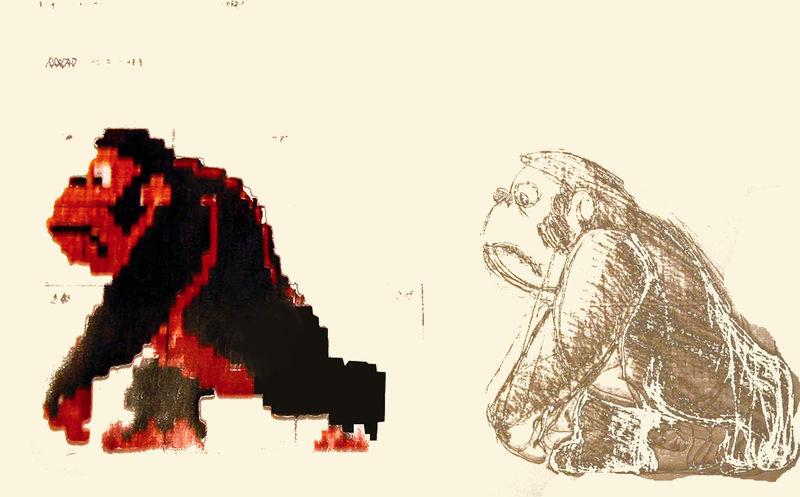
A concept artwork of Donkey Kong
from the design stages.
And last but not least, we must mention
Shigeru Miyamoto. This was the first
official work of this gaming mastermind and it was a clear signpost for all of
his future games. With this game, Miyamoto showed only a small part of his
overall innovation skills and creativity, but he also showed that he understands
the gaming business better than any other “player” on the field. It was the case
in the 80s and it is still the case nowadays. The only thing that we can tell
him is “Thank you, mr Miyamoto!”.
Story
As we already said, this is the first
video game ever to feature the story (even though it was pretty basic). A girl
called Lady (she was later renamed to Pauline) is kidnapped by a giant humanoid
gorilla called Donkey Kong, who took her to a place that looks like a giant
construction site. And now, a carpenter named Jumpman is Pauline’s only hope. He
must climb to the top of this construction site and rescue the girl.
As you can see, the story is pretty common and it drew inspirations from various
other films such as Beauty and the Beast and Popeye (there was even an idea to
include the Popeye characters in the game instead of Jumpman, Pauline and Donkey
Kong, but that was quickly scrapped). And more than anything, it drew
inspirations from King Kong (even the character of Donkey Kong was inspired by
this giant monkey). Speaking of this,
Universal City Studios (creators of the
King Kong movie) also saw the opportunity to earn some money on court, by
accusing Nintendo for violating their trademark of King Kong. They charged a
lawsuit against the company, but the whole thing was a complete failure. You can
read more about this case in the “Legal Issues”
section.
So there you have it, that is our short interpretation of this simple and basic
story of the game. And if you want to see what
Nintendo of America has to say
about it, check the following lines:
“HELP! HELP!" cries the beautiful maiden as she is dragged up a labyrinth of
structural beams by the ominous Donkey Kong. "SNORT. SNORT." Foreboding music
warns of the eventual doom that awaits the poor girl, lest she somehow be
miraculously res-cued. "But wait! Fear not, fair maiden. Little Mario, the
carpenter, is in hot pursuit of you this very moment."
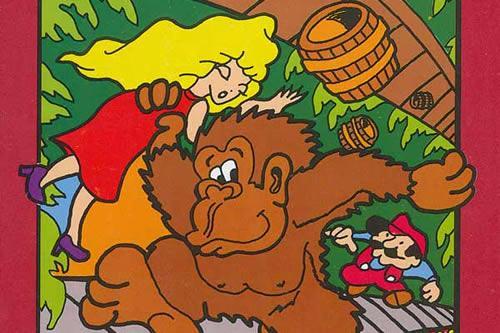
Donkey Kong kidnaps a blonde rendition of Pauline with Jump man in pursuit.
Throwing fate to the wind, risking life and limb, or worse, little Mario tries
desperately to climb the mighty for-tress of steel, to save the lovely lady from
the evil Mr. Kong. Little Mario must dodge all manner of obstacles- fireballs,
plummeting beams and a barrage of exploding barrels fired at him by Donkey Kong.
Amidst the beautiful girl's constant pleas for help, your challenge is to
manoeuvre little Mario up the steel structure, while helping him to avoid the
rapid-fire succession of hazards that come his way.
As little Mario gallantly battles his way up the barriers, he is taunted and
teased by Donkey Kong, who brazenly struts back and forth, beating his chest in
joyful exuberance at the prospect of having the beautiful girl all to himself.
It is your job to get little Mario to the top. For it is there, and only there,
that he can send the mighty Donkey Kong to his mortal doom. Leaving Little Mario
and the beautiful girl to live happily ever after. "SIGH. SIGH."
So, if you want the most exciting, most fun-filled, most talked about family
video game on the market, don't monkey around with anything but the original
Donkey Kong.”
Mario's Origin
Like it was mentioned numerous times
before, this is the game where our favorite video game hero made his official
debut. Sure, it wasn’t exactly the shape and form like the one we know today,
but it was the first game where he appeared in the spotlight and as the lead
character.
The whole thing is very interesting, as his original appearance was slightly
different compared to the character he would later become. First of all, he
isn’t referred to as “Mario” in this game, but “Jumpman”.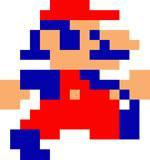 Even though this name
may indeed sound silly at first, it has a big importance. This name basically
illustrated the original concept of Mario’s movement in all of his future games
– jumping. Even though he still wasn’t a plumber in this game (he is a carpenter
here) and even though he doesn’t have much of a personality in this game, the
introduction of the jumping mechanic quickly became one of his trademarks.
Even though this name
may indeed sound silly at first, it has a big importance. This name basically
illustrated the original concept of Mario’s movement in all of his future games
– jumping. Even though he still wasn’t a plumber in this game (he is a carpenter
here) and even though he doesn’t have much of a personality in this game, the
introduction of the jumping mechanic quickly became one of his trademarks.
So, even though there was no way to see such things back at the time, the
importance of this game for the whole franchise is more than huge. We can safely
say that this is also the most important game in the franchise (even though it
isn’t the most popular title). Sure, we owe a lot to the game that saved and
revolutionized the video game industry ( the
original Super Mario Bros.), we
also owe a lot to the game that brought us the third dimension to video games
and that introduced us a whole new way of playing video games (Super Mario 64),
but if it wasn’t for Donkey Kong and “Jumpman” there would be no Mario either.
Based on the rules of logic, you can easily get the overall conclusion.
Gameplay & Controls
As this is the first real platform
game ever, its mechanics are as simple and as basic as they can be. You start
off from the bottom of the construction site and your objective is to climb up,
all the way to Donkey Kong. Of course, this road will not be easy, as he has
plenty of traps for you, so on your way to the top you will have to dodge
barrels that he is throwing, as well as the other obstacles. Anything you touch
kills you instantly. You will also lose a life if you fall down from a big
height. You have 3 lives when you start the game and if you lose all of them,
it’s “Game Over” and you have to start playing the entire game all over again.
The only way to get past the obstacles is to jump over them. And that is
basically one of the two things you will be doing all the time. The other one
involves climbing the ladders. Some of the obstacles (springboards) bounce up
and down, so in that case it is better to time it correctly, so that you move
“underneath” them (when they are up in the air). Along with jumping over/getting
under the obstacles, moving and jumping, there is an item that can help you
destroy those hazards, and that is the hammer. It is placed on one of the two
sides of a platform, and once you get it, you can destroy anything you touch
(except the huge monkey himself). What is the sad thing about it, you may ask?
It lasts only temporarily *sigh*.
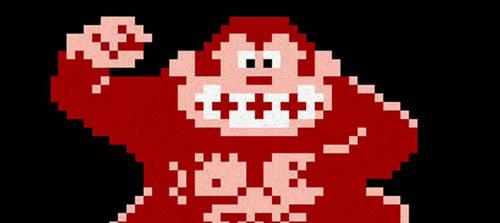
When we speak of the gameplay, we must also note that the game is really short.
It is understandable though, as it was still the pioneer age of the video game
industry, and this was THE biggest thing back at the time. There are only 4
levels in total. After you beat the 4th level, you will save Pauline and
ultimately “beat” the game. The game doesn’t end though, it resumes with
replaying all the levels in a higher difficulty. And this happens every time you
beat the game again and again, you just continue playing, but all levels become
harder and harder. Once you reach “the 22nd level”, you will realize that there
is a programming bug and the game will kill you off completely. That is the very
end of the whole thing. If you want to find out more about the stages
themselves, you can check out the “Stages” section.
As for the controls themselves, they are also as basic as they can be, adding
even more to the simplistic, addictive gameplay that was so popular at the time:
Left/right on the D-Pad - Move left/right
Up on the D-Pad – Used for climbing the ladders
A – Jump
Start – Pause the game.
Characters & Enemies
On this list you can find more
information about the characters and enemies that appear in this game. There are
very few of them in both categories, but anyway………..
Characters
Jumpman – Our hero himself. With a different name, different profession (do we
really need to repeat again that he is a carpenter in this game?) and a
different mission, it is still the character we love the most. We can’t tell him
to say hi to Princess Peach, as he is still with his old girl here, we can’t
tell him to eat as many mushrooms as he likes, as that is what comes later in
the timeline, but we can tell him: “Jump Mario, jump”! Remember “Forrest Gump”
and the legendary “Run Forrest, run”? Well, it’s that sort of thing…….
Lady – Later known as Pauline, she is the original damsel-in-distress and
Mario’s first love interest. She is the girl that is kidnapped by the giant
monkey and she is the one that our Mario has to save. She is not a princess like
Peach, she is a normal civilian and a normal human being. We don’t have many
details about her personality, but since our Jumpman falls in love with her……….eeeh,
we can at least say that she is handsome, can’t we? She has a different look and
a different role in the newer Mario games, but her character is still the same.
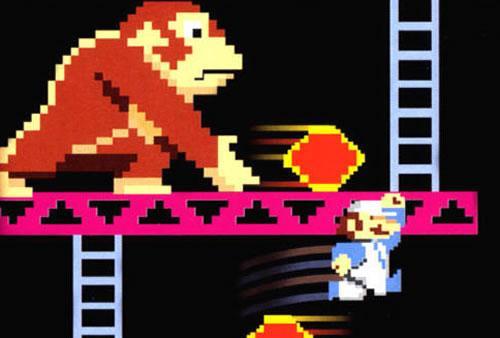
With malice in his pixelated eyes, Donkey Kong hurls fireballs at a blue-white clad rendition of Jump Man (from the cover of the GBA's Classic NES series release of Donkey Kong)
Donkey Kong – The main antagonist of this game. A giant King Kong-like monkey is
not an animal you should mess with! Unless you are THE Jumpman and unless your
love interest is kidnapped. He is the only one who can beat the giant monkey and
save the day.
Even though many believe that this is the same Donkey Kong as the one in the
Donkey Kong Country franchise, we must tell you that it is not. It is, in fact,
his grandfather – Cranky Kong! Yes, the same old senile monkey with long and
boring stories and a huge life experience to back it up. Shocked? Surprised?
Well, don’t be, because you have just learned something new thanks to us, and
now you can mock the fellow Donkey Kong Country fans who, we guarantee you, have
no idea about this!
Enemies
Barrels – The standard enemies in the game. They are thrown by Donkey Kong and
they roll from the top all the way down to the bottom of the stage. You can
dodge them by jumping over them and you can also destroy them by using the
hammer.
Fireballs – Originally seen in the second stage of this game (50 m), they emerge
from oil stations that are set on fire. They move left and right and they can
also climb up or down the ladders. You can jump over them to dodge them and get
points, or you can destroy them with the hammer.
Sand Piles – They are only seen in the second stage of the game (50 m) and they
are found on the conveyer belts. You can destroy them with the hammer, just like
the other enemies.
Springboards – Perhaps the trickiest enemies, as they bounce up and down in a
very fast manner, so you need to be very careful if you want to avoid them!
Contrary to what you are doing to dodge other enemies, to safely evade
springboards you must pass underneath them when they are up in the air. You can
ultimately destroy them with the hammer.
Items, Objects and Power-ups
There is not a huge amount of items,
objects and power-ups that you will encounter in this game, but we will now list
them anyway……….
Hammer – The most useful item in this game. Once you acquire it, you are
practically invincible and you can destroy all the obstacles that happen to be
on your way. The only bad thing is that it lasts for a short period of time. But
anyway, it is better that you have something like this than nothing at all,
right?
Pauline’s lost items – These are the items that Pauline dropped after Donkey
Kong took her away. There are 3 types of Pauline’s lost items: umbrellas, hats
and purses. They are optional collectable items, which means that you can
recover them if you want (in order to earn some extra points by doing so), but
it is not a must, so the choice is really up to you. It should be added that the
NES version of the game doesn’t have hats in it (they are replaced with second
umbrellas).
Rivets - These yellow items appear in the final stage of the game (100 m) and
you need to collect each and every rivet in order to make the platform on which
Donkey Kong is standing collapse. There are 8 of them in total (6 in the
Game
Boy version of the game).
Stages
We already wrote some things about
the stages of this game, but this section will cover all the information you
need about this topic…
The game has 4 levels in total:
1. 25 m
2. 50 m
3. 75 m
4. 100 m
As you might have noticed, each new section is 25 m taller than the previous
one.
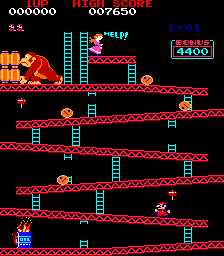
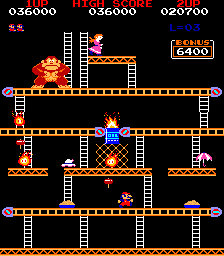
The 25m stage (left) and 50m stage (right) of Donkey Kong for the NES
The first section (25 m) consists of seven floors filled with grids and ladders.
The enemies you will encounter in this level are the barrels that Donkey Kong is
throwing as well as the fireballs (that emerge once the barrel smashes the oil
station at the bottom left corner of the level). Once you manage to climb to the
top, Donkey Kong will take Pauline to the next section and the game continues
there.
The second section (50 m) is similar to the previous one. There are grids and
ladders once again, but this time there are some conveyor belts that carry
cement bags as well, and you can use them as elevators. Fireballs reappear in
this level, and for the first time there are some springboards as well. The
level is beat in the same way as the previous one – by making it to the top
without getting killed by the obstacles you encounter on your way up.
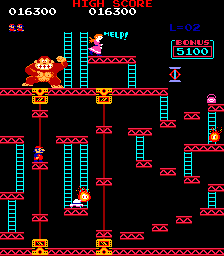
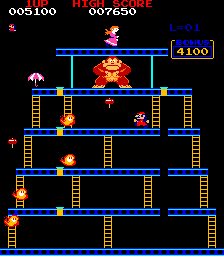
The 75m stage (left) and 100m
stage (right) of Donkey Kong for the NES
The third section (75 m) is a tougher version of the previous section. You need
to go up by riding the elevators and avoiding numerous springboards and
fireballs. Interesting fact about this level is that it is an unlockable stage
in Super Smash Bros. Brawl.
The fourth and final section of the game (100 m) is the one where you finally
get to take down the big and ugly monkey. You need to remove 8 rivets that
support the platform on which Donkey Kong is standing, which will cause him to
fall down. By doing so, you need to dodge fireballs that reappear in this stage
as well. After you manage to do so, Donkey Kong will fall down and Jumpman will
reunite with his love interest.
After you beat the 4th level, you will start playing the entire game all over
again, but in a higher difficulty. And this repeats until you reach the 22nd
level. Once you start playing that one, the game will kill you off because of a
programming glitch and it will ultimately end the game.
Releases
Following a huge success of the arcade original, plenty of other versions of the game were released, and even the spin-off content as well. The game inspired a cartoon series as well, and it started as early as 1983. It was produced by Ruby-Spears studio who also made a Donkey Kong Jr cartoon series. The plot of the show revolves around solving mysteries and Mario and Pauline chasing after Donkey Kong who escaped from the circus. It had 2 seasons.
The intro to the Donkey Kong Jr.
cartoon series
Due to the game’s immense popularity back at the time, many video game companies
wanted to have it on their own consoles. Among others, Nintendo refused to hand
over the rights to Taito, who offered a huge amount of money to buy them. Coleco
and Atari had more success though. They approached both the Nintendo in United
States and Japan and the negotiations were successful. Coleco was granted an
exclusive console and the rights on the game. They were, thus, the first company
that was granted with permission to port the game to their own console. Nintendo
believed that they were an ambitious company with a strong marketing department,
so they saw a chance to receive undisclosed lump sum plus additional profit from
game cartridges and from tabletop units as well. The contract was drafted by
Howard Lincoln near the end of 1981 and it had an interesting clause- Coleco
would be responsible for anything that is found on the game’s cartridges.
Nintendo’s representative signed the document the following day, while the
representative of Coleco did so in the first day of February 1982.
Coleco did not distribute the game in the form of stand-alone cartridges. It
came as part of their
Colecovision system, which went on sale in Q2 1982. Six
months later, the same company offered Intellivision and
Atari 2600 versions of
the game as well (though, an interesting thing has to be noted and that is they
didn’t port it to
Atari 5200, and that was probably because the specifications
of that system were similar to the one of their own console). The sales
increased in the following months, and Coleco’s console versions of the game
managed to sell 6 million cartridges in total, earning the profit of $153
million. The same company released stand-alone
Mini-Arcade tabletop versions of
the game. They managed to sell 3 million units together with
Pac-Man,
Frogger
and Galaxian. In the meantime, Atari got the license for the PC versions of the
game. As a result, the game was released on the Atari 8-bit computers. Along
with that, Atari developed several other ports of the game under the label of
Atarisoft (in 1983). All of those versions had the cement factory level (that
was missing in many console versions, including the NES one), so they were
complete games. None of the home versions of the game had all the cutscenes
and/or the animations from the arcade original. Along with that, some versions
have Donkey Kong on the left side in the 25 m stage, and some have reversed 25 m
stages with Donkey Kong on the right side.
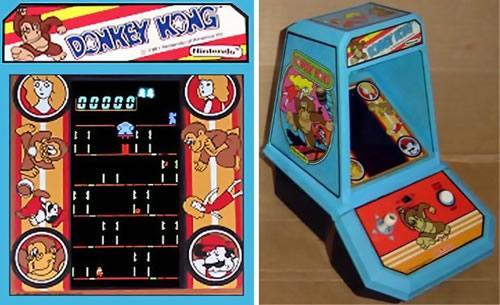
A mini-arcade tabletop version of
Donkey Kong, courtesy of
Retroist.
Shigeru Miyamoto created another exclusive version of the game, this time for
the
Game & Watch system. It had the same core and the same gameplay as the
arcade original, however the overall design was slightly different and it was
played on 2 screens (just like the rest of the Game & Watch titles). Along with
that, ports of the game became available on
Amiga,
Atari 7800,
Intellivision,
Commodore 64 &
VIC 20,
Famicom Disk System, IBM PC Booster,
ZX Spectrum,
Amstard CPC, MSX, Atari 8-bit family and in form of the Mini-Arcade versions. A Famicom port was released in 1983 as one of the console’s several launch titles.
Along with that, it was an early title for the NES in North America. The cement
factory, as it was already noted, was not included in these versions of the
game, and most of the cutscenes and animations from the arcade original were
left off as well, because Nintendo didn’t have cartridges with enough memory
back at the time. However, what these 2 versions do have is a new title screen
theme, composed by
Yunio Kaneoka. This tune also appears in Donkey Kong Country
on the SNES (in a rearranged form though). Both this game and its sequel (Donkey
Kong Jr.) were included on the 1988 compilation cartridge
Donkey Kong Classics,
for the NES. The NES version of the game was later also re-released as part of
the Animal Crossing game on the Nintendo
GameCube, and also as a purchasable
item on the
Virtual Console for the
Wii, 3DS and the Wii U. The
Wii U version
is, up to this date, the last version of the game and it was released to
celebrate 30 years of the Famicom Disk System. The NES version was also released
on the e-Reader and on the
Game Boy Advance Classic NES series in 2002 and 2004.
The Famicom version managed to sell 840 000 units in Japan. The original arcade
version also appears as part of Donkey Kong 64 on the
Nintendo 64.
Last but not least, there was another port of the game. It is called Donkey Kong
– Original Edition and it came as part of 25th Anniversary PAL region red Wii
systems in 2010. It was also given to the 3DS users who registered the selected
3DS titles on the
Nintendo eShop until 6th January 2013. This version is a
classic rip-off of the NES version, however it was packed with the cement
factory stage and the animations and intermissions that was previously left off.
The game became available for purchase in Europe as well (in September 2014).
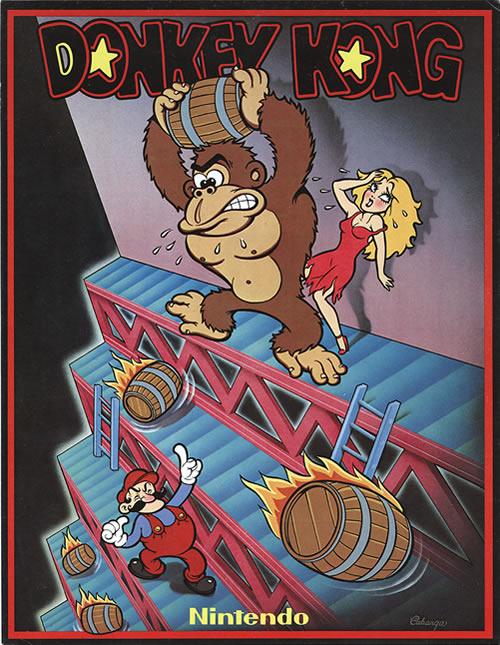
A poster advertising the arcade
version of Donkey Kong
Differences between versions
Although the basic concept of the
game is the same, regardless of the version that you are playing, the overall
experience is different. There are some notable differences between each and
every version of the game, and all of them affect the overall impression of the
whole package.
So, on this place you can find out what you can expect from each version of the
game and what are the notable differences between them. Also, be aware, we are
going to state our personal opinion of the changes and/or the games themselves
as well, so don’t get upset if your opinion is different.
Arcade version
“Nothing beats the original”. This is something that all of us often hear at one
point or another, and this is something that is very true. In this case, the
arcade original is indeed the best version of the game and also the only version
where you can really feel that you are getting the maximum from this game. The
game plays and feels great, especially for its time. The controls are tight and
responsive, the framerate is very good and the animation is fluid. There are
some short cutscenes as well (like the one where Donkey Kong takes Pauline and
climbs the ladder as soon as Jumpman gets near) that additionally contribute to
the overall enjoyment factor.
This is the best version of the game and the one that all the others are trying
to be.
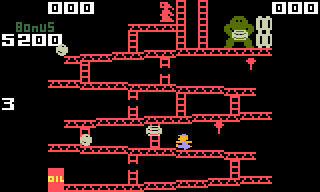
Intellivision version
OK, before we can say anything about this version in particular, let’s get this
thing straight and loud……..YOU DON’T WANT TO PLAY IT! TRUST US ON THIS, YOU
DON’T WANT TO!
Words cannot describe how horrible this version is. It is horrible and it fails
on every possible level. The graphics are so bad that we can’t stop getting the
impression that they would’ve looked better if they were drawn by a 1 year old
kid. The characters in the game look nothing like them. Jumpman looks like a
completely random dude, Donkey Kong doesn’t even look like a monkey at all in
the first place, he is just some green…….strange thing here and Pauline is
completely pink, from the top ‘till the bottom! And when we say that she is
actually the closest they managed to get to the original………..it says it all.
But, visuals aside, it would be acceptable if the gameplay is fun and if the
game is functional. But guess what? The gameplay is horrendous and the game is
barely functional. The controls are horrible and the whole game is almost
unplayable.
It is no wonder why even the developers were ashamed to put a screenshot of
their own game on the cover art. This excuse for a video game is the worst
version of Donkey Kong out there. Avoid it at all costs!
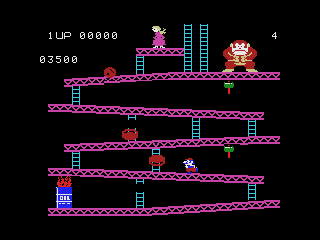
Colecovision version
Miles above the previous mentioned version. Aside from the fact that some colors
are changed (for example, the hammers have green tops and umbrellas are white
with red stripes) and that there are no cutscenes at all (even when you die you
don’t see Jumpman falling down, but instead you just hear the “life lost” theme
and the game pauses), this is quite a solid version of the game, especially for
its system. The controls feel a bit stiff at times, but it’s nothing terrible.
The visuals are good, just like the sprites too, however Donkey Kong himself
looks a bit…….weird…….and angry. Also, it is interesting to note that both
Colecovision and Intellivision versions have “reversed” 25 m stages.
Overall, this is a good version that is worth playing, especially for people who
are fans of retro gaming.
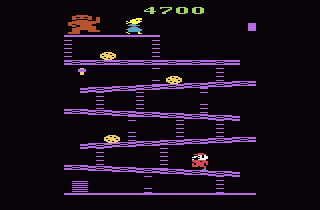
Atari 2600 version
It is very hard not to burst into a laughing marathon as soon as you start
playing this one. It is a tough question what version fails more, this one or
the Intellivision version, but one thing is certain – this is a very bad version
of the game.
Just like Mario Bros. is massacred heavily on this system, Donkey Kong suffered
the same fate. The stage design is ridiculous. There are some obvious mistakes
in the drawing, and you will either see the ladders that are “stuck” in the air
and that lead nowhere, or the ladders that are incomplete. Interestingly enough,
Jumpman is designed appropriately (to some degree), but Pauline and Donkey Kong
are so out of place that it hurts to watch! Pauline looks nothing like she looks
in the arcade version, and Donkey Kong looks like………we don’t even know how to
describe it, but the closest we can get to is E.T. (I know what you are thinking
right now…….. “please don’t mention that game”). The controls are all out of
place again and the sound effects are a real pain for one’s ears.
Do yourself a favor and avoid this version.
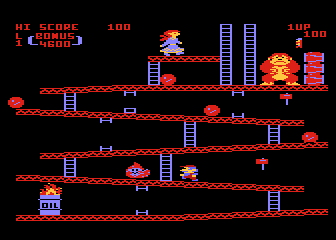
Atari 8-bit version
Well……….the only thing we can say is that it is better than the Atari 2600
version but it lacks many things to be a decent port. First of all, even though
the visuals are quite good, the character design is slightly off. Donkey Kong
has a really strange appearance, and judging to the way his face looks here, we
can as well call him “Baby Kong”. Pauline is completely off and she looks like a
totally different character. One may ask if this is really her or it is another
girl. And Jumpman………well, the color combination is correct, but he also has a
strange appearance, and his head looks bigger than his body. The sound is also
quite off and the whole game sounds like a disoriented orchestra. The gameplay
is solid, but with the above things mentioned, we can’t say that this is really
a version that you must play.
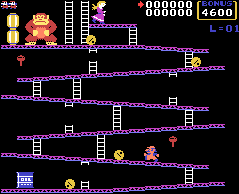
TI-99/4a version
Some parts of this port are really good and some are not. We can’t escape from
the fact that it looks, feels, plays and sounds like an incomplete package. The
gameplay is solid, the animations are also ok, but some things are quite off.
While the sprites of Jumpman and Pauline are adequately taken over from the
arcade original, Donkey Kong once again has a ridiculous appearance and he looks
even more “baby-face” than in the previous version. He also appears to be
holding a heart (?!). There are no animations of him throwing the barrels and he
looks like he is someone who is observing the environment and not like the
game’s antagonist. Barrels also look like they are carried over from the Atari
2600, while the overall level design (the platforms, the grids, etc…….) is quite
good. When you look at those 2 things alone…….it just doesn’t work. Also, there
is no cutscene where Donkey Kong takes Pauline with him, but after Jumpman gets
near, we see the two of them starring at each other and a heart in the middle -
the same thing that comes after the 100 m stage is beaten.
Generally, this is a poor port, but at least it is functional and it plays
somewhat good compared to Atari 2600 and Intellivision versions, for example.
IBM PC-Booster version
One thing that we can guarantee you is that your first reaction to this will be
“WTF???”. As soon as you see the gigantic pink letters that look like they are
designed with calcimine, as well as the ultra-miniscule sprite of……..well,
Jumpman we guess, on the title screen.
This could easily be thrown in the same basket with the Atari 2600 and
Intellivision versions of the game. Pretty much everything is completely wrong
here. The whole game is so slow, and when Jumpman is moving you have an
impression like he is going to have a bowel movement on foot. He looks like an
ugly Pinocchio (although, even that is a compliment for this) when he walks, and
he looks like a scarecrow when he is climbing the ladders. Pauline looks like a
tiny 5 year old girl, and she looks like she is Jumpman’s daughter and not his
love interest. And don’t even get us started with Donkey Kong! This is, perhaps,
the worst sprite of Donkey Kong EVER! At least the Atari 2600 and Intellivision
versions had sprites to laugh at, but this is scary! He looks more like Chesire
Cat than Donkey Kong. He is pink and looks twisted and scary! Whoever designed
him must have been on some sort of drugs. No offence, but it’s true! The sound
effects are also totally out of place and it hurts to listen to them.
We can’t think of any excuse why you should try this version of the game. So, if
you don’t want to be a masochist and hurt yourself………avoid this one.
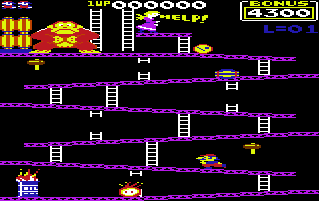
Commodore 64 version
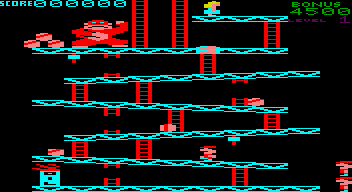
VIC 20 version
Commodore 64 & Vic 20
A good port for a change! This version is actually quite good. The only real
problem is that the visuals are poor (both the character design and the level
design) but it plays and feels very good. The framerate is really good,
especially for the system, the controls are very responsive and there are some
nice animations as well.
So, if we leave out the poor visuals, this is a very good version and it is
definitely worth playing.
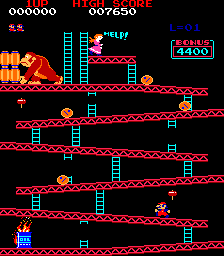
NES version
One of the best versions of the game out there. This is almost a perfect port.
It looks, feels and plays almost identical like the arcade version. The only
things that are missing are the cutscenes when you beat the first two stages,
and the fact that this game has 3 stages instead of 4. And this is the biggest
problem with this version, as it is, basically, an incomplete game.
Still, gameplay-wise this is a great version and it resembles the same
addictiveness of the arcade original.
MSX version
Generally, a solid attempt but a port with many problems. It definetly has them,
but it’s not terrible or unplayable. The visuals are (again) a huge problem, and
while Jumpman’s sprite is designed appropriately, Donkey Kong is completely off.
He does look like a monkey, but he has a completely different appearance. And
Pauline? She looks like that symbol you can find on the toilet doors. The
overall level design is also poor and things get discolored at times. The hit
detection is poor and the gameplay is much slower than the one in the arcade
original and the NES, for example. It has fluid animations though, and some cool
cutscenes too (even though they are poor imitations of the original ones).
You can try it if you want, it is not terrible, but it’s not amazing either.
ZX Spectrum version
Almost identical to the MSX version, with the only exception that the visuals
are even worse and the sound effects are way more annoying. In this version,
even Jumpman is completely screwed in his appearance. His look in this version
reminds us of those pink elephants from the Dumbo cartoon.
So, what you have read about the MSX version you can apply here as well, with
addition that the MSX version is the better one (in our opinion).
Amstrad CPC version
Almost completely spot-on! This is more than a decent port of the arcade
original and this is definetly one of the best versions of the game you can
play. The graphics are very good, especially for the system, just like the sound
effects. The game has all the cutscenes like the original version and generally,
it really feels like a complete package. The level and character designs are
spot-on.
This version is a “must play” since it manages to recapture the whole original
feel of the arcade version. This is also THE best port of the arcade version, in
our personal opinion.
Famicom version
As Famicom was the Japanese NES it is obvious that this version is identical to
the NES version. So, everything that you can read for that port applies to this
one as well.
Atari 7800 version
A very good version. Definitely the best version of the game on the Atari
systems, and if it had all 4 stages + all of the “cutscenes”, it would have been
the best port of the arcade original, hands down. It is almost identical to the
NES port with one addition. The sound effects are better and much closer to the
original, while the visuals are a bit worse (they are not bad in any way). So,
whether you choose to play the NES port or this one…………you won’t make a huge
difference since both are great versions. And yet, both are incomplete. But,
regardless of that, it is still extremely fun to play.
e-Reader version
Since this is a direct port of the NES version to the e-Reader it has the same
good and bad sides of it. If you skipped that part, scroll up and then return
here.
Game Boy Advance version
Yet another good port of the game and yet another one that is pretty identical
to the NES version. Just like in the case of Atari 7800 version, it has better
sound effects than the NES version (it even has sound in the background) while
the visuals are inferior compared to the NES port. Not much though, but they are
not as good. And yet again, this version doesn’t have all 4 stages in it.
Still, since it manages to recapture the feeling of the arcade version in a very
good way, you won’t make a mistake if you decide to play this one.
Virtual Console version
Regardless whether we speak about the Virtual Console on the WII, 3DS or the Wii
U, this version is yet another rip-off of the NES port, so everything you need
to know is already listed in the “NES version” subsection.
The King of Kong: A Fist Full of Quarters
The impact of this game is really huge to be measured in words, and that is something that you probably figured out on your own without reading this page. It is so huge that it actually got…….well, sort of a documentary about it.
The King of Kong, a fist full of
quarters DVD.
Yep, you heard well. It even got its own documentary. It was released in 2007
and it’s called “The King of Kong: A Fist Full of Quarters”. The film is
dedicated to this game, and the plot revolves around Steve Wiebe who wants to
break the previous world high score in Donkey Kong (set by Billy Mitchell).
Director of the movie (Seth Gordon) stated that the movie could be a sequel
instead of a remake. A sequel that explains how the lives of both of these men
changed after the premiere of this film and how their rivalry is alive and
going. The movie was also dedicated to “the world’s oldest video game champion”
Doris Self, who made an appearance in the movie, but passed away shortly before
its release.
The movie got very good reactions from various critics. Metacritic gave it a
score of 83 out of 100, Rotten Tomatoes gave it a score of 97% while IMDB gave
it a score of 8.2. The movie has also entered several “top 10 best movies of
2007” lists.
References in later games
As a highly influential game, it is just obvious that there are plenty of references in the later titles. If you want to find out more about each of them, then you came to the right place…….
-
Donkey Kong II – This is a direct sequel of the original game
-
Donkey Kong Game & Watch – A special version of the game developed for the Game & Watch system
-
Super Mario Bros. 2 – Clawgrip’s movement is directly inspired by the movement of Donkey Kong from this game. The remakes of this title also have grids in the background of the indoor sections
-
Donkey Kong (Game Boy) - 4 levels from the arcade original are remade in this version of the game. The hammer item, as well as Pauline’s lost items reappear in this game as well. The plot is also ripped off from the original
-
Donkey Kong Country – Donkey Kong reappears in this game, and we get to learn that he is actually the old chump Cranky Kong! So, what we had before was, basically, a younger version of Cranky Kong himself. Cranky also plays the title theme of the arcade version of the game in the intro of this title. The oil drums that are found in Oil Drum Alley are the same oil drums that we can see in the 25 m stage of Donkey Kong
-
Donkey Kong Country 2: Diddy’s Kong Quest – When Cranky says: “Whisking off maidens and chucking barrels seven days a week, I was” he makes a direct reference to this game
-
Super Mario RPG: Legend of the Seven Stars – One of the challenge rooms that can be found in Bowser’s Keep involves Mario avoiding barrels that are thrown by a Chained Kong
-
Donkey Kong 64 – A port of the arcade version of the game can be found on an arcade machine in the Frantic Factory stage. The song that you can hear in Creepy Castle is a cover of the theme that can be heard when Donkey Kong is climbing the ladders after the stage is cleared
-
Donkey Konga – When you get to choose whether you want the 50 Hz or 60 Hz refresh rate, you can notice that Mario’s sprite acts as a cursor and the sprite of Donkey Kong can also be seen on the left side of the screen
-
WarioWare Inc.: Mega Microgame$! – There is a minigame that is directly inspired by this title, in which Mario needs to jump over the barrels
-
Mario & Luigi: Superstar Saga – If Mario jumps when when the Border Bros. tells Luigi to jump, you will hear a direct reference to this game – “give the jumpman thing a rest”. In order to save Luigi in Woohoo Hooniversity, you need to jump over rolling barrels which is another direct reference to this game. And last but not least, there is also a skeleton-pirate that is throwing barrels in a mini-game (in the same fashion as Donkey Kong)
-
Paper Mario: The Thousand Year Door – One of the badges that you can acquire in the game is the Jumpman badge. Along with that, if you return to the Glitz Pit and get the first place again, a person from the audience will say: “JUMPMAN!!! Wait, who? ”
-
Mario Power Tennis – A theme that is heard when Donkey Kong wins the trophy is actually the title music from this game
-
Donkey Kong Jungle Beat – The battle music that plays during the battles with Ghastly King and Cactus King has some parts from this game (when Donkey Kong takes Pauline and climbs the ladder after the stage is cleared)
-
Donkey Konga 3: Tabehōdai! Haru Mogitate 50 Kyoku – One of the themes from Donkey Kong reappears in this title as well
-
Mario Hoops 3-on-3 – Mario’s baller name in this game is…………you guessed it, Jumpman!
-
Donkey Kong Barrel Blast – The theme that plays in Cranky’s flight school as well as Cosmic Highway features the opening theme from this title
-
Super Smash Bros. Brawl – 75 m stage reappears in this game. In addition to that, there are also coves of the title theme and 25m stage theme. A demo of this game is also playable on in form of a Masterpiece
-
WarioWare D.I.Y. Showcase – There is a small microgame that is directly inspired by this game. The objective is to destroy the rolling barrel by tapping it
-
New Super Mario Bros. Wii – Broozers have the same moving patterns like Donkey Kong. They can pick-up and throw barrels in the same fashion
-
Donkey Kong Country Returns – The background of Foggy Fumes has the 25 m stage on it. You can also find a statue of the Donkey Kong sprite that holds a Wii remote in the Wonky Waterway stage. Also, some of the secret temples and stages have elements from this game as well
-
Super Mario 3D Land – At one point during the final battle with Bowser, he will start throwing barrels at Mario just like Donkey Kong
-
Donkey Kong Country: Tropical Freeze – In the Aqueduct Assault there is a statue of the Donkey Kong sprite holding a Wii-U Gamepad
-
Captain Toad: Treasure Tracker – Both the music and the animation that you experience when you pick-up the Super Pickaxe are ripped-off from this game
-
Super Smash Bros. for Wii-U – 75 m stage reappears in this game as well. The game is once again available as a Masterpiece.
Legal Issues
Every now and then you get to hear
about various legal issues, regardless of the subject we are talking about.
Video games are no exception. These problems existed since as early as 1982. The
2 different legal issues about this game happen to be the first 2 serious
lawsuits in the history of video games.
What was the problem in this game you ask? Well….read the following lines to
find out…
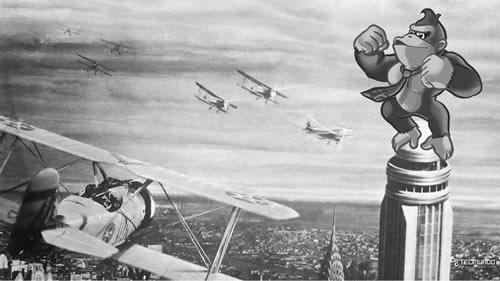
Donkey King Kong by Penguinline on Deviantart - a parody of the Nintendo universal Kong based debacle of 1982.
Issues with Universal
About a year after the game was released (1981),
folks from Universal Studios
decided to sue Nintendo, claiming that the company has damaged the intellectual
property rights they have on the King Kong movie. So, what they basically
thought is that Donkey Kong is a direct rip-off of King Kong, or actually the
big monkey himself! Yep, as silly as it may sound today, that is what happened.
However, Nintendo didn’t want to step back and they had their trumps as well.
The future president of the company Howard Lincoln hired one of the best lawyers
available on the market to represent Nintendo in this case –
John Kirby. Kirby
has not only shown that Nintendo didn’t break any of the copyright laws, but
also that Universal had legal issues with
RKO Pictures in 1975. They sued the
company to prove that the plot of King Kong was in the public domain. After
this, Nintendo managed to win in this fight, and the court demanded that
Universal must pay them a total sum of $ 1.8 million in legal fees. One more
thing has to be noted here – It is also shown that
Tiger’s King Kong video game,
that was licensed by Universal, actually broke the copyrights of Donkey Kong!
Now isn’t that shameful? After this case reached its conclusion, Nintendo
awarded Kirby with a $ 30 000 sailboat and gave him the permission to use the
name of Donkey Kong on the boat itself! Now, that’s a real happy ending.
Despite the fact that this case had a good ending for our favorite video game
developers, it was one of the biggest lawsuits in the video game history. And
most well-known as well. Many different websites still have records and articles
about this case. The Gaming Historian has a very good retrospective of the whole
case, and Techdirt has a short but spot-on article as well. And a spot-on title
as well: “Historical Hypocrisy: Donkey Kong, King Kong, and The Public Domain”.
We can’t stop wondering what would happen if Universal took the victory here? On
Kotaku you can find the article named “In 1983, Donkey Kong Nearly Died” that
begins with the following lines: “As we celebrate what's (probably? Maybe?)
Donkey Kong's 30th birthday, today let's take a look at the 1983 court case
which nearly brought a premature end to Nintendo's big ape”. Whether they are
right or not, we will never find out, luckily. We will never find out because,
among other things, this nonsense was never supposed to happen in the first
place! And since justice won in the end……who cares anyway?
Issues with Ikegami Tsushinki
There was another lawsuit here, and this time with one of the game’s programmers
– Ikegami Tsushinki. Back at the time, Nintendo was lacking programming
resources and they needed help from another company. Tsushinki was appointed to
program the arcade version of the game. For the development of this game, 2
companies signed a contract, and that gave Tsushinki the exclusive rights to
manufacture
Donkey Kong arcade boards.
They sued the company in 1983, claiming that Nintendo has violated the contract
by producing around 80 000 arcade boards on their own. They also demanded a
compensation for the reverse-engineered Donkey Kong code in
Donkey Kong Jr. They
claimed that they owned the copyright on the code itself even though the
contract didn’t specify who was the actual owner.
This case was processed on the
Tokyo Distinct Court until 1990, when the two
sides settled out of court. So, the overall conclusion is…….that there isn’t
any. It is often thought that this particular lawsuit was the reason why there
was an apparent lack in the number of arcade re-releases of the game and why we
have
Donkey Kong: Original Edition, in the first place. However,
Donkey Kong 64
still had a full port of the arcade version, though with huge differences. So,
as there is no real consensus here, you are free to choose your own side and
decide on your own who is guilty here – Nintendo or Ikegami Tsushinki.
Videos - Gameplay, Trailers & Commercials
A playthrough of the NES version of Donkey Kong.
The gameplay from the Atari 2600 version of Donkey Kong
The gameplay from Donkey Kong 1994 on the Gameboy
The Arcade style intro
A TV commercial for the Game Boy version of Donkey Kong
Reception and Sales
The game received great critics and
very positive opinions all over the world. It was and still is one of the most
innovative games of all time. Not to mention (once again) that it is the first
game that made Nintendo the leading video game developer.
Steve Bloom, the author of Video Invaders, described it as “another bizarre
cartoon game, courtesy of Japan”. The game has a very solid rating on IMDB (7.8)
and an excellent 10/10 on HonestGamers.
IGN rated the Virtual Console version of
the game with 4/10 concluding that “the original, true Donkey Kong should be
made available. The original
Mario Bros., or Sheriff, or even the underwhelming
but historically significant Radar Scope. So don't download this version of
Donkey Kong. Send a message that you want the real game. The game that saved
Nintendo from bankruptcy. The game that kept the company from drowning in
thousands of unmarketable arcade cabinets. Give us the real Donkey Kong,
Nintendo, not the same old incomplete port.”
The game was extremely popular in the United States and Canada, and it managed
to sell 2 000 units upon release. By October the game was already selling more
than 4 000 units per month and by June 1982 it managed to sell 60 000 Donkey
Kong machines and to earn $ 180 million. It managed to sell another $100 million
in 1982, making the total profit of $ 280 million (the total profit until this
time is $ 726 million). It was Nintendo’s top seller in 1983 as well. The sales
in Japan were also very good.
In 1983 Arcade Awards ranked the game as “Best Solitaire Video Game”. It was also
awarded with the Certificate of Merit as runner-up for
Coin-Op Game of the Year.
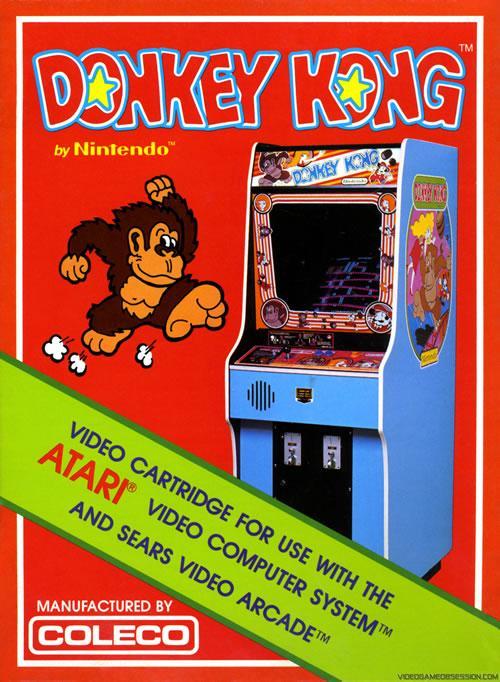
Sales
The NES version of the game sold a total of 1.13 million units globally. Of that
number, 20% (0.23 million) of the copies were sold in North America, 4.9% (0.05
million) of the copies were sold in Europe, 74.3 % (0.84 million) were sold in
Japan and 0.8 % (0.01 million) of the copies were sold in the rest of the world.
The sales figures for the
Atari 2600 version were better, even though it is a
technically inferior version. It sold a total of 1.46 million units globally. Of
that number, 93.4% (1.36 million) of the copies were sold in North America, 5.5%
(0.08 million) of the copies were sold in Europe, and 1.1% (0.02 million) of the
copies were sold in the rest of the world.
World Records
This is one of those games that, even
though it is very basic and simple, has a very high replay value, and it still
feels strong even today. One of the things that highly contribute to this factor
is that it is easy to play in order to improve the time you need to beat it, or
to beat your previous high score. There were even many competitions among
various players around the world in order to obtain the world record high score
(there was a documentary about this too, so if you didn’t see that yet, check
the section #10 on this page). And indeed, we do have an official top 20 list of
world records in this game.
This is how it looks like, up to this day:
1. Robbie Lakeman 1 141 800 points (9/5/2014)
2. Dean Saglio 1 206 800 points (10/4/2013)
3. Hank Chien 1 138 600 points (11/1/2012)
4. Mark Kiehl 1 137 500 points (9/23/2014)
5. Ross Benziger 1 136 500 points (9/26/2013)
6. Vincent Lemay 1 135 900 points (1/11/2013)
7. Jeff Willms 1 107 600 points (8/15/2011)
8. Jeff Wolfe 1 103 700 points (10/30/2013)
9. Steve Wiltshire 1 100 700 points (7/28/2014)
10. Wes Copeland 1 099 500 points (9/30/2014)
11. Dave McCrary 1 091 400 points (2/23/2014)
12. Phil Tudose 1 089 400 points (8/5/2013)
13. Mike Groesbeck 1 076 000 points (5/17/2014)
14. Corey Chambers 1 072 200 points (8/26/2014)
15. Steve Wiebe 1 064 500 points (8/30/2010)
16. Billy Mitchell 1 062 800 points (7/31/2010)
17. Shaun Boyd 1 037 500 points (5/21/2012)
18. Tim Sczerby 1 034 700 points (2/24/2010)
19. Mick Winzeler 1 027 700 points (9/21/2014)
20. Jon McKinnell 1 025 200 points (7/7/2013)
Trivia & Facts
-
This is the first ACTUAL platform game ever, and second in general (the first one is Space Panic). Also, it is a game that originally set the standards that the others followed in the future (both the Mario games and the other games in general)
-
It is the first game that had a story
-
It is the game where Mario made his official debut, along with Pauline and Donkey Kong
-
Mario’s first and original name is seen in this title – It is Jumpman
-
In this game he is not a plumber like it is commonly known nowadays, but a carpenter
-
This is the first work of the legendary developer Shigeru Miyamoto
-
The 22nd level of the game is the final one. It has a programming bug where the game ultimately kills off Jumpman regardless of any of the circumstances. This is commonly referred to as “the kill screen”
-
Mario/Jumpman has a different appearance on the cover art of the NES version of the game – he wears blue and white clothing instead of the familiar red and blue combination
-
The game was originally meant to be a Popeye game. The characters of Donkey Kong, Pauline and Jumpman actually replaced Bluto, Olive Oyl and Popeye, that were originally planned to be the game’s characters
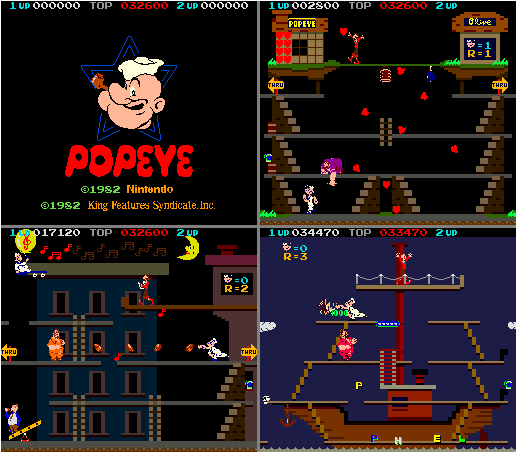
Screenshots from the Pop Eye Videogame, bottom right looking particularly DK tier-based-level-esque
-
2 of the main characters changed their names in the upcoming titles. Jumpman became Mario and Lady became Pauline.
Reference / Information
-
Donkey Kong Amstrad CPC Version - Cheats / Unlockables / Hints
-
Donkey Kong Atari 2600 Version - Cheats / Unlockables / Hints
-
Donkey Kong Atari 7800 Version - Cheats / Unlockables / Hints
-
Donkey Kong Atari 800 Version - Cheats / Unlockables / Hints
-
Donkey Kong Intellivision Version - Cheats / Unlockables / Hints
Media / Downloads

